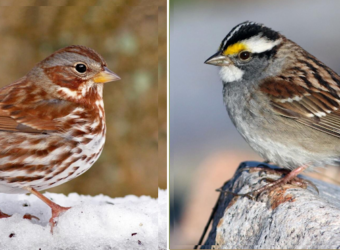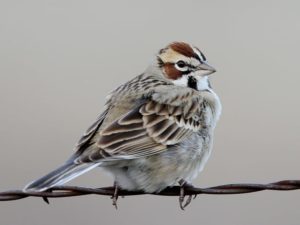A Fascination of Sparrows
A what of what?
I can just hear your snorts of disbelief: How can I possibly associate the word “fascination” with those drab little representatives of the bird world? And I get it: Given the chance to convince a skeptic of the joys of birding, would I choose to introduce them to a sparrow instead of a majestic Bald Eagle, a gorgeous white Great Egret, a gaudy Baltimore Oriole, or even a familiar but colorful Blue Jay?
No, I probably wouldn’t. And for many, many years after I first started paying attention to birds, I also shrugged sparrows off as merely species to glance at before moving on to something more interesting.
These days, though? When I’m with someone else who wants to learn more about the natural world, it isn’t long before I start describing why I think sparrows are fascinating. That, in fact, they’re some of our coolest birds.
How can that be? Here are a few ways:
THEIR BEAUTY IS SUBTLE
Beauty?! I may have lost you already. We all tend to think of sparrows as merely “little brown jobs,” and it’s undeniable that their color palette is limited.
But if every bird were as gaudy as a Peacock or a Scarlet Tanager, we’d soon expect nothing less. (Not every gorgeous flower has to be a sunflower or prize rose.) The truth is that many sparrows are strikingly marked. For example: In breeding season, the familiar White-throated Sparrow has its bright white throat, lemon-yellow spots between its beak and its eyes, a black-and-white striped head, and rufous wings. The Lark Sparrow has a harlequin pattern of red, white, and black on its head and face. And the Fox Sparrow is a mass of reddish-brown—a colorful bird by any standard.
Many other sparrows are far from plain, and even the less vivid species often boast complex patterns of spots and streaks. They’re always worth a closer look.
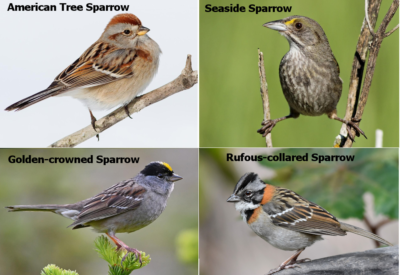
THEY’RE EVERYWHERE
Even a casual nature lover knows that sparrows are always around us: In these parts, Song Sparrows sing in our yards all year long, White-throats hop among the winter weeds, and other species make more occasional appearances. (By the way, the ubiquitous House Sparrows that mob our feeders, take over nests meant for other birds, and generally make a nuisance of themselves aren’t even closely related to our sparrows. They’re destructive pests introduced from the Old World, so don’t tar our sparrows with the House Sparrow brush.)
Though we know that native sparrows are a permanent fixture of our backyards, we don’t always realize that they’re in everyone’s backyard in this hemisphere. Sparrows occupy nearly every ecosystem from above tree line on the highest mountains (American Tree Sparrows) to the edge of the sea (Seaside Sparrows, naturally), and from the Arctic tundra of northern Alaska (Golden-crowned Sparrows) to the island of Tierra del Fuego south of continental South America (Rufous-collared Sparrow). These little birds are astonishingly adaptable, setting up camp anywhere there’s food to be found.
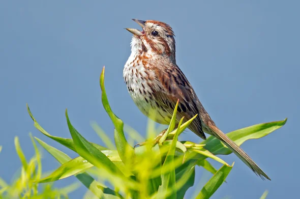
Listen to Song sparrows here: https://www.allaboutbirds.org/guide/Song_Sparrow/sounds
THEY’RE COMPLICATED
Did you know that every Song Sparrow on earth sings a different song? It’s true, and it’s very, very unusual in the bird world. Most birds follow a relatively simple process as they learn to sing: They study their parents’ songs in the weeks after hatching, just as they model other behaviors that will soon allow them to go off on their own.
Young Song Sparrows, however, are tutored not only by their parents but by neighboring birds, and they don’t just learn when they’re young, but for a whole year or two. That means that while every individual sings a mix of notes, trills, and buzzes, each one develops its own unique mix. As if that isn’t creative enough, one bird might sing 20 different songs and invent up to 1000 variations on its basic theme.
No one has yet figured out why Song Sparrows do this while other birds don’t. I think that maybe they just enjoy it.
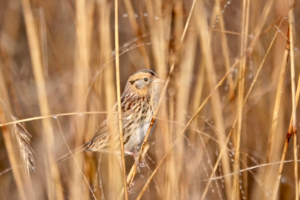
THEY CHOOSE US
As long as we don’t disturb them, one thing connects a Great Blue Heron stalking in the shallows, a Red-tailed Hawk perched regally on a branch, and an American Robin singing in a treetop: They don’t pay any attention to us. Meanwhile, other, shyer species may take a single glance at us and fly off or hide in dense underbrush.
But there are certain sparrows that don’t follow this either/or rule. Instead, they do both: One moment they may decide to stay hidden among long grasses or underbrush, remaining invisible for hours to every eager birder searching for them. And then, with no warning at all, they’ll pop up, casual and unafraid, to give a chosen onlooker a clear view.
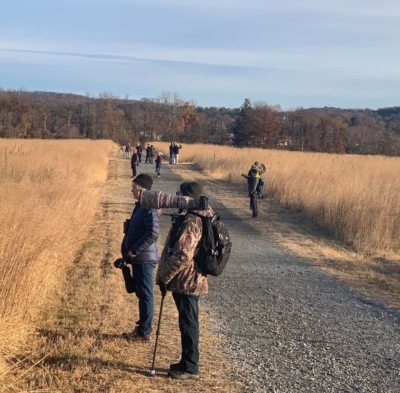
These little sparrows have attracted birders from near and far, many of whom have spent fruitless hours on end (days, even) searching for them. If you’re very lucky, though, a LeConte’s will suddenly pop into view, glowing orange in the sun, watching you with as much interest as you’re watching it. (“Why do you care about me so much?”) After a little while, it’ll disappear back into the grasses again…and though you’ll know it’s still there, you won’t catch another glimpse of it.
Perhaps it’s because I was one of the lucky pursuers (average LeConte Search Time for my two sightings: three minutes), but I think any bird that decides when it wants to be seen and when it doesn’t is worthy of our admiration and curiosity.
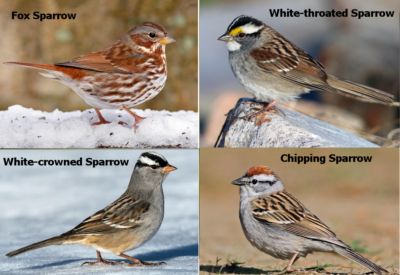
*
So, have I convinced all the skeptics out there yet?
Maybe not, but in writing this essay I think I convinced myself. I still love the show-off birds, but for that unbeatable combination of subtlety, adaptability, creativity, and agency, I’ll take sparrows.
by Joseph Wallace
Copyright © 2021
